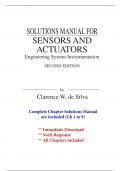SOLUTIONS MANUAL FOR
SENSORS AND
ACTUATORS
Engineering System Instrumentation
SECOND EDITION
by
Clarence W. de Silva
Complete Chapter Solutions Manual
are included (Ch 1 to 9)
** Immediate Download
** Swift Response
** All Chapters included
, CONTENTS
Preface
Chapter 1 Instrumentation of an Engineering System
Chapter 2 Component Interconnection and Signal Conditioning
Chapter 3 Performance Specification and Instrument Rating Parameters
Chapter 4 Estimation from Measurements
Chapter 5 Analog Sensors and Transducers
Chapter 6 Digital and Innovative Sensing
Chapter 7 Mechanical Transmission Components
Chapter 8 Stepper Motors
Chapter 9 Continuous-Drive Actuators
iii
, PREFACE
This manual is prepared primarily to assist the instructors who use the book SENSORS
AND ACTUATORS—Engineering System Instrumentation, 2nd Edition. It includes hints
for structuring the material for a course in the subject and provides complete solutions to
the end of chapter problems of the textbook.
The book SENSORS AND ACTUATORS—Engineering System Instrumentation,
nd
2 Edition, introduces the subject of Engineering System Instrumentation, with an
emphasis on sensors, transducers, actuators, and signal modification devices.
Specifically, it deals with “instrumenting” an engineering system through the
incorporation of suitable sensors, actuators, and associated interface hardware. It will
serve as both a textbook for engineering students and a reference book for practicing
professionals. As a textbook, it is suitable for courses in control system instrumentation;
sensors and actuators; instrumentation of engineering systems; and mechatronics. There
is adequate material in the book for two fourteen-week courses, one at the junior (third-
year undergraduate) or senior (fourth-year undergraduate) level and the other at the first-
year graduate level. In view of the practical considerations, design issues, and industrial
techniques that are presented throughout the book, and in view of the simplified and
snap-shot style presentation of more advanced theory and concepts, the book will serve as
a useful reference tool for engineers, technicians, project managers, and other practicing
professionals in industry and in research laboratories, in the fields of control engineering,
mechanical engineering, electrical and computer engineering, manufacturing engineering,
and mechatronics.
The material presented in the book serves as a firm foundation, for subsequent
building up of expertise in the subject—perhaps in an industrial setting or in an academic
research laboratory—with further knowledge of hardware, software, and analytical skills
(along with the essential hands-on experience) gained during the process. Undoubtedly,
for best results, a course in sensors and actuators, mechatronics, or engineering system
instrumentation should be accompanied by a laboratory component and class projects.
Sensors are needed to measure (sense) unknown signals and parameters of an
engineering system and its environment. This knowledge will be useful not only in
operating or controlling the system but also for many other purposes such as process
monitoring; experimental modeling (i.e., model identification); product testing and
qualification; product quality assessment; fault prediction, detection and diagnosis;
warning generation; and surveillance. Actuators are needed to “drive” a plant. As another
category of actuators, control actuators perform control actions, and in particular they
drive control devices. Since many different types and levels of signals are present in a
dynamic system, signal modification (including signal conditioning and signal
conversion) is indeed a crucial function associated with sensing and actuation. In
particular, signal modification is an important consideration in component interfacing. It
is clear that the subject of system instrumentation should deal with sensors, transducers,
actuators, signal modification, and component interconnection. In particular, the subject
should address the identification of the necessary system components with respect to
type, functions, operation and interaction, and proper selection and interfacing of these
components for various applications. Parameter selection (including component sizing
and system tuning) is an important step as well. Design is a necessary part of system
v
, instrumentation, for it is design that enables us to build a system that meets the
performance requirements—starting, perhaps, with a few basic components such as
sensors, actuators, controllers, compensators, and signal modification devices. The main
objective of the book is to provide a foundation in all these important topics of
engineering system instrumentation.
A Note to the Instructors
A syllabus for a fourth year undergraduate course or a first year graduate course in the
subject is given below.
CONTROL SENSORS AND ACTUATORS
Prerequisites
For engineering graduate students: motivation
For undergraduate students: A course in feedback controls
+ consent of the instructor
Introduction
Actuators are needed to perform control “actions” as well as to directly “drive” a plant
(process, machine, engine). Sensors and transducers are necessary to “measure” output
signals for feedback control, to “measure” input signals for feedforward control, to
“measure” process variables for system monitoring, diagnosis and supervisory control,
and for a variety of other purposes of measurement.
The course will study a selected set of sensors, actuators, and signal modification
devices as employed in robotic and mechatronic systems. General and practical issues of
sensors and actuators in an engineering system will be discussed. Operating principles,
modelling, design considerations, ratings, specifications, selection, and applications of
typical sensors and actuators will be studied. Filtering amplification, error analysis, and
estimation from measured data will be covered as complementary topics.
Textbook
De Silva, C.W., SENSORS AND ACTUATORS—Engineering System Instrumentation,
Taylor & Francis, 2nd Edition, Taylor & Francis/CRC Press, Boca Raton, FL, 2015.
vi




